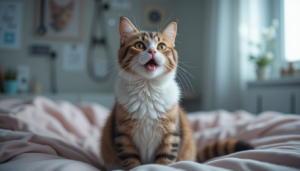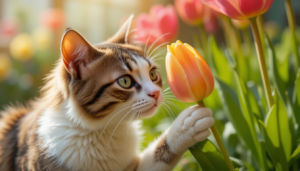As obligate carnivores, cats thrive on a meat-based diet rich in animal proteins and fats. Their digestive systems aren’t designed to process carbohydrates efficiently, which raises questions about common human foods like bread.
Many cat owners report their feline companions showing interest in bread, whether it’s stealing a bite of toast or pawing at a sandwich.
This comprehensive guide examines whether bread is safe for cats, its potential health impacts, and safer dietary alternatives.
With insights from veterinarians, we’ll help you make informed decisions about sharing this human food with your feline friend.
Is Bread Safe for Cats? The Veterinary Perspective
According to Dr. Scott Huggins, DVM, a veterinarian at Farmina Pet Foods:
“Plain white or wheat bread in very small amounts isn’t toxic to cats, but it provides no nutritional benefit. The real concern comes from common bread additives that can be extremely dangerous for felines.”
Key Considerations About Bread and Cats:
- Basic Bread Ingredients:
- Flour, water, and yeast are non-toxic in tiny quantities
- Contains no protein or nutrients cats require
- Hidden Dangers in Store-Bought Breads:
- Raisins (toxic, can cause kidney failure)
- Garlic and onions (damage red blood cells)
- Chocolate chips (theobromine poisoning risk)
- Artificial sweeteners like xylitol (extremely toxic)
- Digestive Challenges:
- Cats lack sufficient amylase enzymes to break down carbohydrates
- High gluten content may trigger food sensitivities
Nutritional Breakdown: Why Bread Fails as Cat Food
A typical slice of white bread (about 25g) contains:
| Nutrient | Amount | Relevance for Cats |
|---|---|---|
| Calories | 67 kcal | Empty calories with no benefit |
| Carbohydrates | 13g | Difficult to digest |
| Protein | 2g | Insufficient (cats need 25-30g/day) |
| Fiber | 0.6g | Minimal digestive benefit |
| Sugar | 1.1g | Contributes to obesity risk |
Veterinary Insight:
“The carbohydrates in bread convert to sugar in your cat’s body. Over time, this can lead to weight gain and potentially diabetes, especially in indoor cats with lower activity levels,” explains Dr. Huggins.
Potential Health Risks of Feeding Bread to Cats
1. Immediate Digestive Issues
- Bloating and discomfort from yeast fermentation
- Diarrhea due to inability to process gluten
- Vomiting from sudden dietary changes
2. Long-Term Health Consequences
- Obesity: Empty calories contribute to weight gain
- Diabetes Mellitus: Chronic carb overload strains insulin production
- Nutritional Deficiencies: Displaces essential meat proteins
3. Allergic Reactions
Some cats develop:
- Itchy skin and excessive grooming
- Chronic ear inflammation
- Digestive disorders like IBD
Safe Feeding Guidelines (If You Choose to Share)
For owners who want to occasionally offer bread:
✔ Only plain white or wheat bread (no seeds, nuts, or flavorings)
✔ Pea-sized portion (no more than 1-2 times monthly)
✔ Always supervise for adverse reactions
✔ Best served toasted (reduces yeast activity)
Pro Tip:
“Spread a thin layer of plain meat baby food on toast if you want to make it slightly more nutritious,” suggests Dr. Huggins.
Healthier Alternative Treats for Cats
Instead of bread, consider these vet-approved options:
Protein-Based Treats:
- Cooked chicken breast (no seasoning)
- Freeze-dried salmon bites
- Small pieces of hard-boiled egg
Low-Carb Vegetables:
- Steamed green beans
- Baked carrot slices
- Pumpkin puree (for fiber)
Commercial Cat Treats:
Look for:
- 70% meat content
- Grain-free formulas
- Added taurine for heart health
Emergency Situations: When to Call the Vet
Seek immediate veterinary care if your cat consumes:
🚨 Raisin bread (even a few raisins can cause kidney failure)
🚨 Garlic bread (toxic at 1g per 5lb body weight)
🚨 Moldy bread (tremorgenic mycotoxins are deadly)
Symptoms Requiring Urgent Care:
- Excessive drooling or pawing at mouth
- Lethargy lasting over 12 hours
- Blood in vomit or stool
- Loss of coordination
Frequently Asked Questions
1. Can kittens eat bread?
No. Kittens require precise nutrition for proper growth and development. Bread offers none of the essential amino acids like taurine that growing cats need. The carbohydrates may also disrupt their delicate digestive systems, potentially causing diarrhea during this critical life stage.
2. Is whole grain or sourdough bread better for cats?
Not necessarily. While whole grains offer more fiber for humans, cats derive no benefit from these complex carbohydrates. Sourdough’s fermentation process doesn’t eliminate the fundamental issue – cats lack the digestive enzymes to properly break down any type of bread effectively.
3. Why does my cat seem to love bread so much?
This attraction typically stems from:
- The yeasty smell that mimics meat proteins
- Texture curiosity (soft, chewy foods interest cats)
- Learned behavior if previously rewarded with bread
4. Can bread help with hairballs?
Contrary to popular belief, bread doesn’t aid hairball passage. The lack of meaningful fiber means it’s ineffective. Better solutions include:
- Regular brushing
- Veterinary-approved hairball formulas
- Pumpkin puree (1/4 tsp daily)
5. How much bread is dangerous for cats?
Toxicity depends on:
- Cat’s size (5lbs vs 15lbs makes a big difference)
- Bread type (plain vs toxic ingredients)
- Frequency (single incident vs chronic feeding)
As a general rule:
- 1-2 small bites of plain bread may cause mild upset
- 1 entire slice could trigger serious digestive issues
- Any amount with toxic ingredients requires vet care
Conclusion: The Final Verdict on Cats and Bread
While the occasional crumb of plain bread won’t harm most healthy cats, it serves no purpose in feline nutrition. The risks of digestive upset, potential exposure to toxic ingredients, and long-term health consequences outweigh any perceived benefits.
Key Takeaways:
- Bread offers no nutritional value for cats
- Many varieties contain hidden dangers
- Meat-based treats are always superior
- When in doubt, consult your veterinarian
By understanding your cat’s unique dietary needs, you can make better treat choices that support their health and longevity. Remember: when those pleading eyes beg for your sandwich, there’s always a safer alternative to offer!
Have more questions? Book a nutritional consultation with your vet to discuss your cat’s individual needs.




